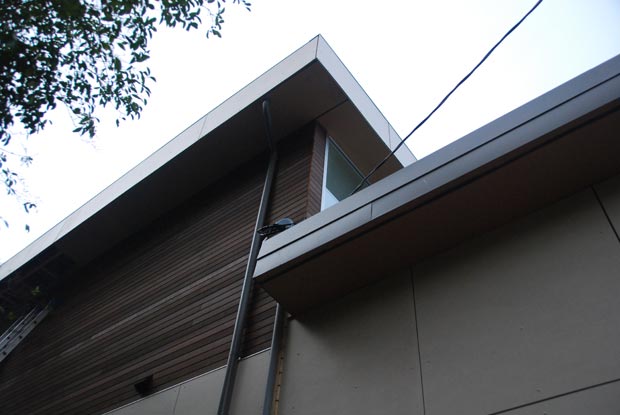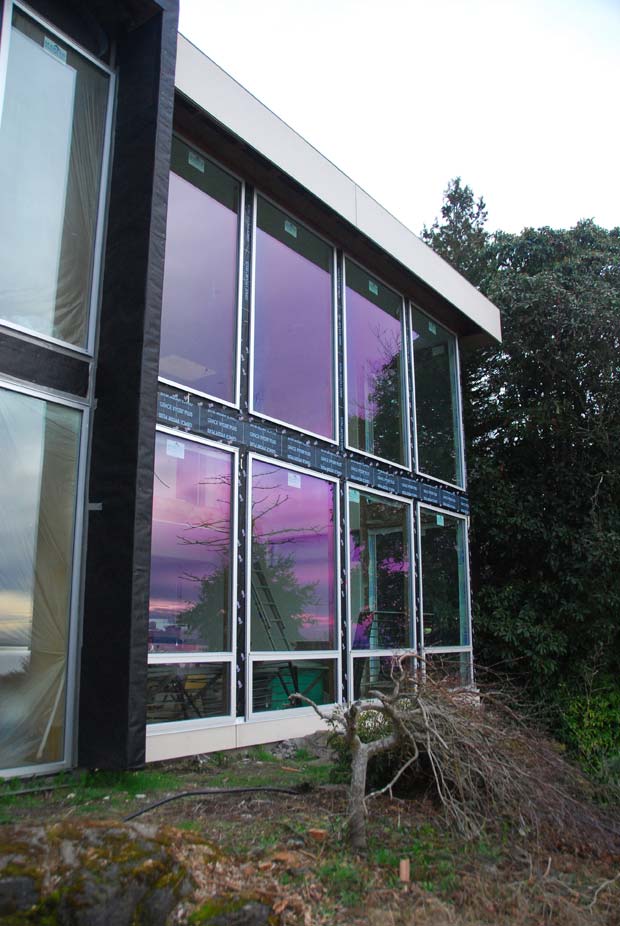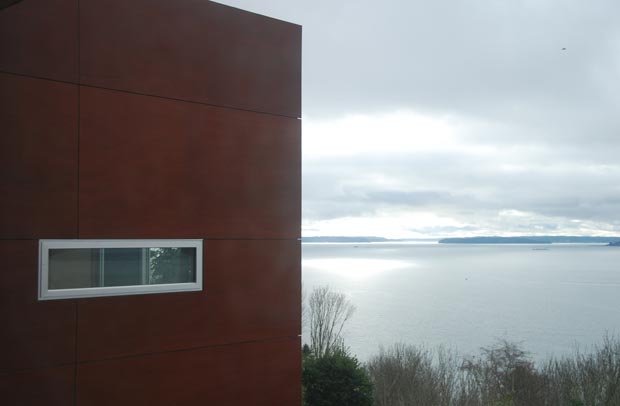Siding is finally (almost) done.
I’ve gotten into a bad habit on this blog of waiting until major stages are complete or major decisions are made before posting. It makes for good, succinct reading, without a ton of incomplete updates every other day, but the downside is that I lose the ability to take advice from readers before strings are pulled. For that reason, I’m going to try and post more frequently until the project is complete, starting now.
The big news of the week is that siding is finally nearing completion. Given how many different materials I’m using and how much detail is involved, it’s taken about a month and a half to side the house so far, and there’s still probably a week or two left. Brett Deerly and the crew over at Deerly Construction have done a great job so far, often working on weekends, and pounding away in the driving Seattle rain. Getting rainscreen siding to align perfectly is a difficult task and I’m really happy with the results so far.
The specifics of the siding are as follows:
The lower massing

The ground level of the house is clad in rainscreen paneling made by Cembonit. Although rainscreens have been used in Norwegian architecture for centuries, they only made it to the United States during the 1950s. Within the last several years, they’ve gained popularity in American modern home design.
The concept behind a rainscreen is that you have a waterproof, Gore-Tex-like fabric wrapping your framing and then solid panels installed over the Gore-Tex. The panels catch most of the rain carrying it down to the ground while the fabric catches and repels the rest. The panels have quarter-inch gaps between them so they effectively let the whole assembly “breathe”. The idea is that you concentrate more on letting water get out of the structure as opposed to keeping it from getting in. Sealed materials like stucco try to do the opposite: keep water out at all costs. The problem with this strategy, however, in a wet environment like Seattle, is that if it fails (which it often does), it fails badly. Water gets trapped inside the stucco and you have major problems. When you see houses or condos getting their siding replaced within ten years of going up, this is usually what has happened.
Truth be told, I actually prefer the look of well done stucco or wood siding, but the practical benefits and low maintenance of the rainscreen system made it desirable for this project.
We chose Cembonit because unlike the more commonly used HardiePanel siding, it is pure cement board. There are no cellulose fibers, and thus it is extremely rigid and durable. It also comes pre-dyed in several colors, so it doesn’t require any painting (although you can paint it if you’d like).
It turns out Cembonit is not being shipped to North America anymore, but we found a place in Kentucky that had a bunch of it and got a great deal at $4 per square foot. The siding is more or less the color of light concrete… a little warmer maybe.
The upper massing

We ended up going with locally-grown red cedar, stained dark brown, for the upper massing of the house. Although I love the look of wood, I hate the maintenance of it, so we limited our use of wood siding to areas mostly sheltered by eaves. The wood will clearly see a bit of sun and rain, but not as much as other, differently-clad areas of the house. We went with a semi-transparent stain in order to let some of the woodgrain show through but still maintain a reasonable amount of protection against the elements.
One thing I’m not super excited about right now is the corner detail of the cedar siding. One side is just kind of butted up against the other side at the corner, exposing the edge grain, which is currently unstained. When the edge gets stained, it will certainly look better, but it seems like mitering the corners would have produced a slightly cleaner look. We’ll see how that one turns out though… could be perfectly fine once it’s done.
The west window wall

The giant wall of windows facing Puget Sound will be clad in anodized aluminum to match the window frames. This should produce a pretty dramatic, but hopefully not overly bright effect. Not that this is important to me, but I imagine this will make the house pretty unmistakable from the water and even possibly from Bainbridge Island.
The box

The box is the signature design element of the entire house. It’s the sort of thing you’d more often see in the design of a museum than a residence. For this reason, it was crucial we clad it in a material that was attractive and wouldn’t weather with the elements. Build initially pushed hard for brazilian ipe, but I was too afraid of what it would look like when it inevitably silvered. Part of the challenge of the box, is that some of it is inside and some of it is outside. Some faces east, some faces west, some faces north, and some faces south. Its exposure to the elements is very uneven and so it was important to choose a material that would stay as pristine as possible no matter what exposure it received.
I also didn’t want any more cold, industrial material like metal because I’m trying to keep the house warm looking (often a challenge in modern home design).
The only material that fit the bill perfectly was something called Prodema. Prodema is, according to the company, “a high-density panel comprised of a thermosetting phenolic resin bonded cellulose fiber core faced with natural wood that has been coated with Prodema in-house formulated acrylic resin-PVDF protective finish ensures a panel colour fastness of 3-4 in a 3000 hour xenon lamp test (by NEN-ISO 105-a03) and perfect resistance to loss of gloss (by DIN 67530).”
In other words, it’s a mostly synthetic panel with a real wood veneer that is maintenance-free and extremely resistant to water and sun. Real wood without the trouble of real wood. I’d seen Prodema on a couple of other houses in Seattle as well as some commercial applications and it always looks great. I’ve heard some stories about Prodema failing, but the warranty should take care of that if it happens.
Another challenge we had when deciding how to wrap the box was how it would carry through to the inside of the house. In the end, we decided to wrap it a couple of feet into the interior, on all sides. Carrying it along the entire interior of the box would have looked dramatic, but it was too risky and too ripe for looking dated more quickly.
And finally, I would be remiss if I didn’t mention that there is a similar material called Ecoclad that is made less than an hour away in Tacoma that we could have used instead of the Spanish-made Prodema. Unfortunately, however, the company refused to send us any samples, and I’ve heard from others that they are very difficult to deal with. Such a huge wasted opportunity to use a local material. Thanks for making me ship over a $14 per square foot product from Spain instead.
It’s going to take me awhile to put together the timelapse of the siding but I’ll post it as soon as I have it. For now, there are photos in the gallery.
Costs accrued during this stage:
| Cement Board Fabricators (Cembonit) | $13,581.00 |
| Specialty Forest Products (cedar siding) | $4,972.00 |
| Prodema siding (Formas) | $15,237.00 |
| Pacific Delivery Service (siding) | $359.00 |
| Snyder Architectural Systems (siding wrap) | $1,730.00 |
| Brett Deerly (siding labor) | $21,581.00 |
| Excel coatings (stain and treat cedar with Benite) | $1,752.00 |
| White Cap Construction Supply (siding supplies) | $265.00 |
| Lumbermen's ProBuild (siding supplies) | $339.00 |
| Blackstock Lumber Co., Inc (siding supplies) | $44.00 |
| Precision Fabricators flashing (siding supplies) | $521.00 |
| Miscellaneous siding supplies | $1,244.00 |
| Heavy equipment rental | $912.00 |
| Aluminum siding (Special Projects Division) | $3,419.00 |
| Compton Lumber (siding materials) | $426.00 |
| Aluminum anodizing (Hytek Finishes) | $360.00 |
| Scissor lifts (United Rentals) | $1,540.00 |
| Additional siding labor (Brett Deerly) | $1,863.00 |
| Miscellaneous expenses | $379.00 |
| Hauling | $680.00 |
| Honeybucket rental | $117.00 |


Mike, The house is looking great and the view is fabulous!
I’m loving this house and I don’t even really care for modern architecture. I think this is probably the single most interesting blog I’ve ever read.
I do have one question, would you expect to be able to get your full investment back if you were to ever sell this house? My impression was that you have no intention of ever selling this house, but just curious how you would expect that to work out if you ever did.
Jacob: Always tough to tell in a market like this, but there’s a house for sale at the other end of the neighborhood for almost $6 million and another one for about $4 million, and I’d rather have this one than either of those two (and suffice it to say… I’m not spending anywhere close to that amount). Granted, “for sale” does not equal “sold for”, but just to be rubbing shoulders with that price range makes me feel pretty confident long-term.
I just used EcoClad on a job and loved it. I know they have had huge demand for this new product but they did come show us samples and we chose from that. I’ve used Prodema & Parklex on a couple others and have had delam and water wicking problems in the Northwest weather. The project looks great, I hope you don’t have any issues with the cladding.
Seattle Designer: Care to elaborate on either the Ecoclad or the Prodema? Only reason I ask is that you’re posting anonymously so I’d like to make sure you’re not from Ecoclad. I’ve had that happen a few times already on this blog. Thanks…
Not sure when you’ll get there, but there are some beautiful contemporary house numbers available from Chiasso. Could be great for your place:
http://www.chiasso.com/shopping/outdoor/outdoor-accessories/numero-house-numbers.aspx
Mike,
Really enjoy your blog and the great info… Hoping to build a contemporary ourselves this year. Much like yours with butterfly standing seam shed roof et al… Getting our second version of the plans together after the first needed to be revised down due to budget…
Got to your blog thru looking at rain-walls for exterior finishes. Something that suits the design style that’s for sure. When you have a chance would be interested in seeing some additional ‘detail’ photos esp inside/outside corners and around doors/windows. Not much info on gutters/downspouts, but would be interested in anything you have to offer. Suspect that’s a major consideration in your climate!!!
vr
Mark
Mike-Great Blog and wonderful photos
If the Seattle Designer is still following this, please elaborate regarding your Prodema Failure. I am considering this product for a house in the Sierra Nevada Mountains.
wow those prodema panels look fantastic. i’m curious about the durability. i’m in ny so need something that can survive the snowy winters and hot summers and salt air (i’m near the beach)
do you mind if i ask about pricing and lead times relative to say cedar siding?
thanks for all the great info
Mike: There’s something like a 20 year warranty on the ProDema panels. Experiences are mixed, of course, but I’ve heard mostly good things. Also, you can expose all pricing information on this blog by clicking the link in the left navigation.
Does anyone know whether/how rainscreen cladding systems like Predema or Ecoclad are fire rated? We’re building a house in California in a Wildland Urban Interface zone and are under some strict regulations (http://osfm.fire.ca.gov/strucfireengineer/pdf/bml/wuiproducts.pdf). Seems like blown embers could find their way behind the panels just like rain….
Also would appreciate links to impages of what the unstained ipe “silvering” looks like after several years. Does anyone know if the deck shown on the page of the Mullen Stree house above representative (http://craigsteely.com/projects/mullen_street)?
Thanks and great blog. Terry
Hello Terry,
My name is Linda and I am familiar with the Trespa phenolic panel used for rainscreen cladding systems. The Trespa assembly has been tested and meets UL standards for fire safety in both the US and Canada. The system can not be extrapolated and must be installed by a Certified Installer to meet code compliancy. The components of a Trespa panel are integrated in the manufacturing process and will not exhibit the characteristics of a panel that uses a wood veneer over a phenolic core. Unlike a real wood veneer Trespa does not need to be sealed after cutting or drilling and in a climate that experiences freeze thaw conditions, you can be sure that Trespa will not absorb any moisture around exposed edges that will expand during freezing conditions and cause delamination. The Trespa panel will not exhibit “snakeskin” shedding of the surface finish, Trespa is UV stable and will not fade or discolor, Trespa is EBC cured which means the surface is nonporous making it extremely easy to clean.
(Editor’s note: Based on her email address, Linda works for a distributor of the Trespa product. Judge accordingly.)
Hi how has the Prodema held up????? I’ve see and heard horrible things about the product. Have they fixed their problem with fading peeling. Im an Architect located in San Francisco. Thanks
John: No problems whatsoever so far. Spotless.
We have Prodema all around our condo building here in Chicago. This was installed in 2007… The Lamination peeled off in 2009.. After going legal, they promised to replace / fix. They haven’t done either one for last 2.5 years. Prodema is based in SPAIN..so if they don’t respond, you are out of luck. We are unable to find new tenants because the Building looks awful, when lamination is peeling!!!!!!!! BEWARE
I loved the look of Prodema and wanted to use it for my urban apartment project. So I took a chance. The finished project was stunning. However, after one winter cycle the clear sealer on the panels started peeling off, resulting in a leaving a very unsightly appearance. After a long and protracted negotiations with Prodema (Spain), they admitted that the sealer application on the panels was flawed and agreed to replace all the panels. But they would not pay for the labor for removal and replacement. In the end it cost me a bundle to repalce the panels. Needless to say I will not use Prodema again. There are other composite rainscreen panels around as it is getting more popular in the US.